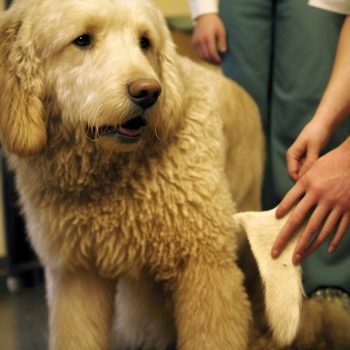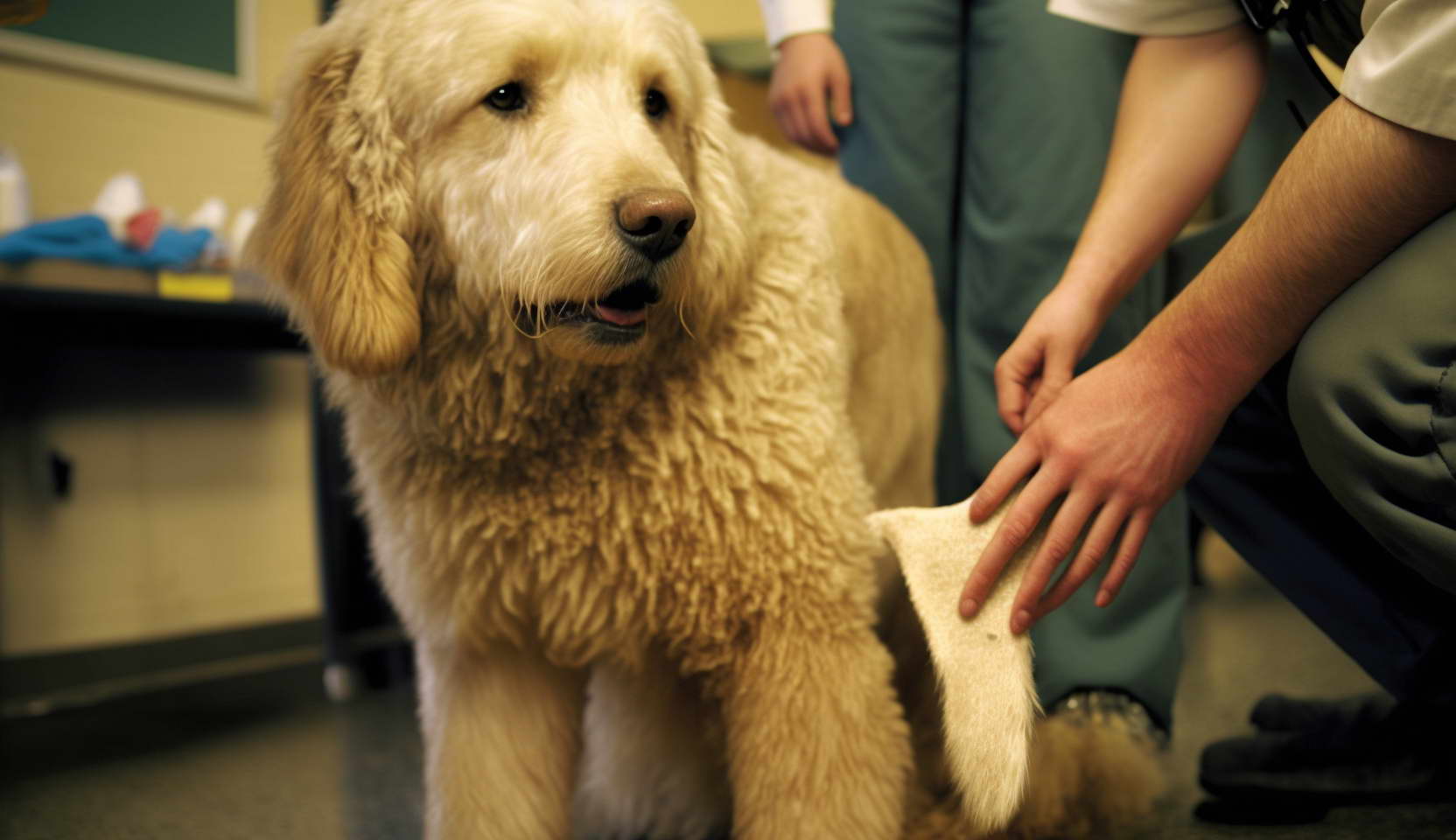Goldendoodle Hip Dysplasia: Understanding, Prevention, and Treatment
Hip dysplasia is a genetic disorder that can affect any dog breed, including the Goldendoodle. This condition occurs when the hip joint fails to develop normally, leading to shallow and unstable sockets in the hip joint. With time, this leads to pain, stiffness, and eventually osteoarthritis of the joint. In this article, we’ll cover everything you need to know about Goldendoodle hip dysplasia: its causes, symptoms, prevention methods, and treatments.
What Is Goldendoodle Hip Dysplasia?
Goldendoodle hip dysplasia is a genetic disorder that affects the hip joint of Goldendoodles. This condition occurs when the hip socket fails to develop properly, leading to an unstable joint with shallow walls and pain/ stiffness at first. Over time, however, this joint deteriorates leading to pain/ stiffness/osteoarthritis eventually developing on either hip. Goldendoodle hip dysplasia can range in severity from mild to severe – impacting one or both hips equally.
Causes of Goldendoodle Hip Dysplasia
Goldendoodles suffer from hip dysplasia, an abnormal growth of bone around their hip joint.
Goldendoodle hip dysplasia is caused by both genetic and environmental factors. While certain genes for hip dysplasia can be passed down from parents to their offspring, not all dogs with these genes will develop the condition. Furthermore, environmental elements like poor nutrition, overfeeding, rapid growth, and excessive exercise may all play a role in the development of hip dysplasia.
Symptoms of Goldendoodle Hip Dysplasia
Does your Goldendoodle have symptoms associated with Goldendoodle hip dysplasia?
The symptoms of Goldendoodle hip dysplasia can vary depending on its severity. Common signs and symptoms include:
- Limping or lameness
- Difficulty rising or lying down
- Stiffness and pain in the hip joint
- Reluctance to exercise or play
- Bunny hopping gait (both hind legs move together)
- Clicking or popping sound at the hip joint
- Loss of muscle mass in hind legs.
How is Goldendoodle Hip Dysplasia Diagnosed?
Goldendoodle hip dysplasia can be diagnosed through a physical exam and diagnostic imaging, such as X-rays. During the physical exam, your veterinarian will look for signs of hip dysplasia such as pain, stiffness, and reduced range of motion. X-rays will show the extent of hip dysplasia and any other abnormalities within the joint.
Prevention of Goldendoodle Hip Dysplasia
Although hip dysplasia has a genetic component, you can take steps to reduce the likelihood of your Goldendoodle developing this condition. Some tips for preventing hip dysplasia include:
- Selecting a reliable breeder who screens their puppies for hip dysplasia
- Feeding your Goldendoodle an appropriate diet to promote healthy growth
- Avoiding overfeeding and rapid weight gain
- Limiting high-impact exercise, particularly during the first year of life.
- Support your joint health with joint supplements and antioxidants by taking these steps.
Treatment of Goldendoodle Hip Dysplasia
Unfortunately, there is no cure for hip dysplasia; however, there are various treatment options available – read more below:
Lifestyle Changes for Goldendoodle Hip Dysplasia
Are You Struggling with Goldendoodle Hip Dysplasia? Lifestyle changes can help manage this condition.
Lifestyle changes can help manage the symptoms of Goldendoodle hip dysplasia and enhance your dog’s quality of life. Some examples include:
- Provide your pup with a comfortable and supportive bed to rest on,
- Avoid high-impact exercises and activities that place strain on the hip joint
- Provide moderate exercise such as swimming or walking on flat surfaces
- Maintain an ideal weight to reduce the strain placed on this joint
- Utilizing ramps or stairs to help your dog access high surfaces
- Offering physical therapy to improve muscle strength and joint mobility
Supplements and Medications for Goldendoodle Hip Dysplasia
Supplements and medications can help manage the symptoms of Goldendoodle hip dysplasia and promote joint health. Some potential supplements or medications to consider are:
- Glucosamine and chondroitin for joint health and inflammation
- Omega 3 fatty acids reduce inflammation and enhance joint mobility
- Nonsteroidal anti-inflammatory drugs (NSAIDs) for pain management and inflammation
- Corticosteroids in severe cases for pain reduction and inflammation reduction.
Surgical Options for Goldendoodle Hip Dysplasia
What Are My Options When it Comes to Surgery?
Surgery may be necessary in severe cases of Goldendoodle hip dysplasia. Potential surgical solutions that could be beneficial include:
- Femoral head osteotomy (FHO): Removal of the head of the femur to reduce bone-on-bone contact and pain
- Total hip replacement (THR): Replacement of the entire hip joint with an artificial joint
- Double pelvic osteotomy (DPO): Reshaping pelvic bones for improved stability in the hip joint
Conclusion
Goldendoodle hip dysplasia is a relatively common condition that causes pain, stiffness, and reduced mobility in affected dogs. Although there is no cure for hip dysplasia, there are various treatments available to manage symptoms and improve joint health. By working together with your veterinarian and taking proactive steps to prevent hip dysplasia in your Goldendoodle, you can help them live a healthy and active life.
Goldendoodle Hip Dysplasia FAQs: Questions
- Can Goldendoodle hip dysplasia be prevented?
Although hip dysplasia has a genetic component, you can take steps to reduce the likelihood of your Goldendoodle developing this condition. Selecting a reliable breeder who screens their dogs for hip dysplasia and providing your Goldendoodle with a balanced diet and moderate exercise are two ways you can reduce this risk. - What are the signs of Goldendoodle hip dysplasia?
Signs may include limping or lameness, difficulty rising or lying down, stiffness and pain in the hip joint, reluctance to exercise or play, bunny-hopping gait, clicking or popping sound in the hip joint, as well as loss of muscle mass in hind legs. - How is Goldendoodle Hip Dysplasia Diagnosed?
Goldendoodle hip dysplasia can be diagnosed through a physical exam and diagnostic imaging, such as X-rays. - What are the treatment options for Goldendoodle hip dysplasia?
Treatment options for Goldendoodle hip dysplasia include lifestyle modifications, joint supplements, and medications, as well as surgery in severe cases. - Can Goldendoodles with hip dysplasia lead a normal life?
Yes! With proper management and treatment, Goldendoodles living with hip dysplasia can lead to an active and normal existence.


Leave a Reply